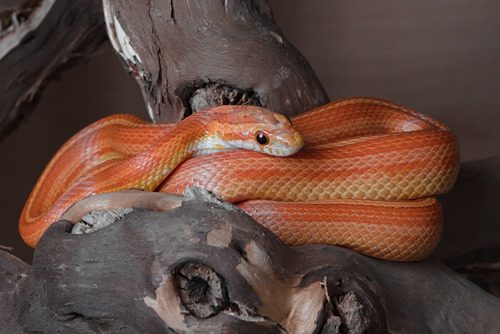Why Is My Pet Snake Not Eating?
Owning a pet snake can be a unique and rewarding experience. However, when your pet snake stops eating, it can be concerning and puzzling. There are several reasons why a pet snake might refuse food, ranging from environmental issues to health problems. Understanding the possible causes and knowing when to seek professional help is crucial for maintaining your snake’s health and well-being.

Common Reasons Why Pet Snakes Stop Eating
Environmental Factors
One of the most common reasons for a pet snake not eating is its environment. Snakes are sensitive to their surroundings, and even slight changes can affect their appetite.
- Temperature: Snakes are ectothermic, meaning they rely on external heat sources to regulate their body temperature. If the temperature in their enclosure is too low or too high, they may refuse to eat. Ensure the enclosure has a proper temperature gradient, with a warm side and a cool side, to allow your snake to regulate its body temperature effectively.
- Humidity: Inadequate humidity levels can also impact a snake’s appetite. Different species of snakes have different humidity requirements, so it’s essential to research and maintain the appropriate humidity level for your specific snake.
- Lighting: Proper lighting is crucial for a snake’s health. Some snakes require a specific light cycle to mimic their natural environment. Ensure your snake’s enclosure has a consistent day-night cycle, which can help stimulate their appetite.
- Enclosure Size and Setup: A cramped or improperly set up enclosure can stress a snake, leading to a loss of appetite. Make sure the enclosure is the appropriate size for your snake and includes hiding spots, climbing areas, and other enrichment items.
Health Issues
Health problems are another significant reason why a pet snake might stop eating. Identifying and addressing these issues promptly can make a big difference.
- Shedding: Snakes often refuse food when they are about to shed. This is a natural process, and your snake should resume eating once the shedding is complete.
- Parasites: Internal or external parasites can cause discomfort and a loss of appetite in snakes. Regular veterinary check-ups and parasite control are essential for keeping your snake healthy.
- Respiratory Infections: Snakes can develop respiratory infections, which can make eating difficult. Signs of a respiratory infection include wheezing, mucus discharge, and open-mouth breathing. If you notice these symptoms, contact your veterinarian immediately.
- Mouth Rot: Also known as infectious stomatitis, mouth rot is a bacterial infection that affects a snake’s mouth and gums. It can make eating painful and should be treated by a veterinarian.
- Other Illnesses: Various other illnesses, such as gastrointestinal issues or organ dysfunction, can cause a pet snake not to eat. A thorough veterinary examination is necessary to diagnose and treat these conditions.
Behavioral Factors
Stress
Stress is a significant factor that can cause a pet snake not to eat. Various factors can contribute to stress in snakes.
- Handling: Excessive handling or rough handling can stress a snake. Limit handling to essential interactions and ensure it is done gently.
- New Environment: Moving to a new environment or changes in the enclosure can cause stress. Give your snake time to adjust to new surroundings before expecting it to eat.
- Presence of Predators: If your snake feels threatened by other pets or even people, it may stop eating. Ensure the enclosure is placed in a quiet, secure location where your snake feels safe.
Breeding Season
During the breeding season, snakes may refuse food as they focus on reproduction. This behavior is more common in males but can also occur in females. If your snake is of breeding age, this could be a natural and temporary cause for its lack of appetite.
Dietary Preferences and Feeding Issues
Food Type
Snakes can be particular about their food. Some may refuse to eat if the food item is not to their liking.
- Live vs. Frozen-Thawed: Some snakes prefer live prey, while others may only eat frozen-thawed prey. Experimenting with different types of food can help determine your snake’s preference.
- Prey Size: If the prey is too large or too small, your snake might refuse it. Ensure the prey size is appropriate for your snake’s size and species.
Feeding Techniques
The way you offer food to your snake can also impact its willingness to eat.
- Presentation: Some snakes prefer their food to be presented in a specific manner. For example, dangling the prey with tongs to simulate movement can entice a reluctant eater.
- Feeding Time: Snakes are often more willing to eat during specific times of the day. Experiment with feeding your snake at different times to see what works best.
When to Seek Veterinary Help
If your snake has not eaten for several weeks or exhibits signs of illness, it’s essential to seek veterinary help. A professional can conduct a thorough examination and provide the necessary treatment to get your snake back on track. Remember, early intervention can prevent more severe health issues and ensure your snake remains healthy and happy. For more information or to schedule an appointment, call Paws and Claws Animal Medical Center in Dunedin, FL.
Maintaining Your Snake’s Health and Appetite
Understanding why your pet snake is not eating involves considering various factors, from environmental conditions to health and behavioral issues. Monitoring your snake’s habitat, health, and behavior closely can help identify the cause and determine the best course of action. If you have concerns about your snake’s eating habits or overall health, contact Paws and Claws Animal Medical Center at (727) 953-6588 for professional advice and assistance.
